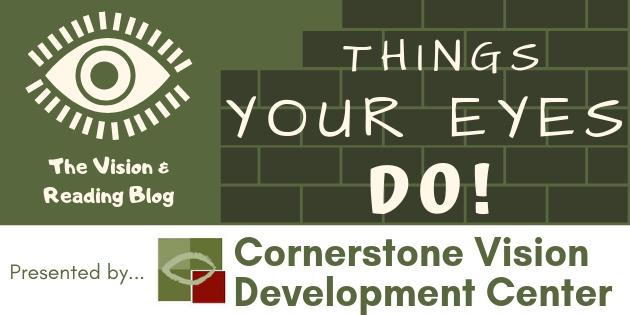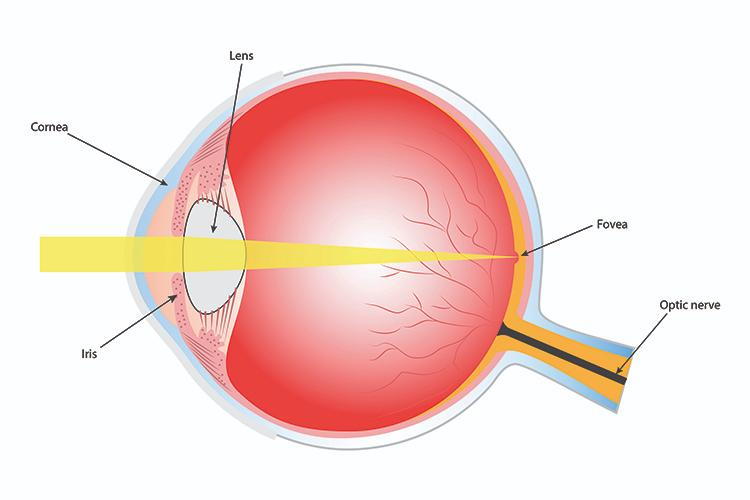
All right, all right, all right! I’m so excited for today. If you aren’t there yet, that’s fine. I have plenty of energy--and coffee--for the both of us. (Totally waving my jazz hands all around right now. Good thing I’m alone in the office for the moment.)
I’m excited because this is the first blog I’m writing about a developed visual skill rather than the structural, and more widely-known, eyesight stuff I’ve been posting as a warm-up. Ah, such powerful stuff. Let’s get started!
This basic skill, what we title “Fixation” in our field, can be watered down to this simple definition:
Your eyes point to look at stuff.
Fixation is very much dependent on the eye structure we discussed before. And NOW, you can understand the other pieces in more beautiful detail! (LOVE this lifelong learning thing.)
Anyone remember that *stellar* running analogy I made in my first post? Lol. Note sarcasm. I know, not that memorable. It went something like, “relying on 20/20 eyesight alone to say you have perfect vision is like saying the only thing it takes to be a good runner is the right pair of shoes.” (Whoa. Check out these fancy ones.)

Although acuity is an extremely integral part of your visual system, just as proper shoes are important for runners, it doesn’t do much good on its own. You have to train your body-- refining neurological connections-- to use your whole visual system as efficiently as possible. Fixation is one of those developed skills.
Remember how we talked about refraction, and needing the light to be focused ever-so-precisely on that eensy-weensy spot on the back of your eye? Yeah, the fovea! Good memory.
Although we discussed the need for the right refractive power, we were assuming a very important aspect: that the eye is accurately pointed at the object we’re viewing.

The eye has to be correctly aligned so that light falls on that little spot capable of 20/20 acuity. If it’s even slightly off-set, the focused light doesn’t match up with the dense, detail-seeing cells capable of that fine clarity (cones, yes?!). It instead falls slightly off target, onto what we call a non-foveal region.
If the eye is aligned off target, the brain cannot gather the most accurate information for what you’re trying to look at. It’s missed that “clearest vision” spot.
Sometimes, a person has developed a habit of aligning with a non-foveal region on the retina. Talk about difficult to retrain! Don’t worry: we aren’t going to investigate those more difficult cases in detail today.
Most commonly, the problem with fixation that we work with in-office is associated with fine motor fatigue, or lack of control in the visual motor system. When our optometrists check fixation ability, they want to be certain that each patient’s ability to maintain--that is, hold--fixation is relatively effortless.
When too much energy is required of an unrefined visual motor system, we see patients squirm, squint or frown, and complain of eye strain or fatigue when asked to keep their eyes pointed at an object for a few moments. Eventually, patients with poor fixation ability can either no longer keep their eyes on the presented target, flicking around the room for relief, or their eyes may water, itch, or burn with excessive effort.

Symptoms that patients or their parents report include: it’s hard to keep attention on reading, eye contact is difficult to maintain, or the child becomes hyperactive or anxious in situations that require attention on visual tasks.
Oddly enough, patients with poor fixation maintenance also often struggle with how to effectively make use of their peripheral vision. (Yeah, you sure do use that!)
Accurate fixations married with a good dose of peripheral awareness are key components of an expanse of tasks. Here are three examples you might relate to:
In reading, “chunking” words into phrases.
In sports, the ability to notice who is open while dribbling down the field/ court.
In driving, glancing at the rearview mirror without losing track of the road.
Fixation is also the key foundation for other visual skills. Smooth, slow motions (i.e., pursuits) and quick eye jumps (i.e., saccades) are both built on one’s ability to control how his/ her eye is pointed.
Looks like I’ve rambled enough for one post, though. We’ll have to save those pieces for the next one! Stay tuned for more “Things Your Eyes DO!”
~ The VT Geek
Shannon Gerber, Certified Optometric Vision Therapist
